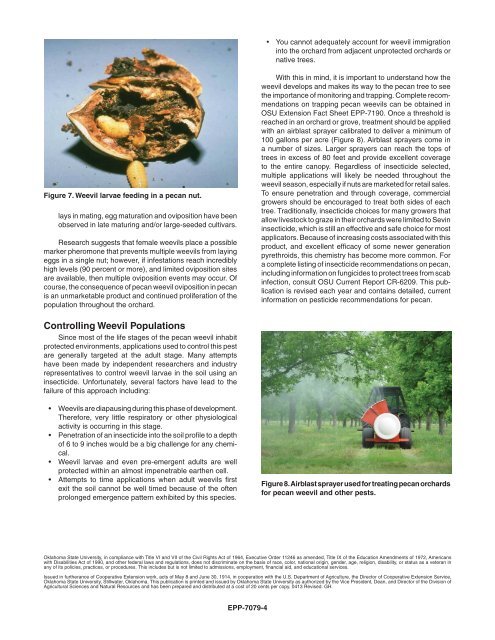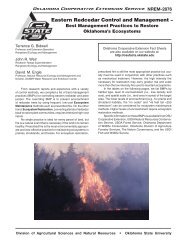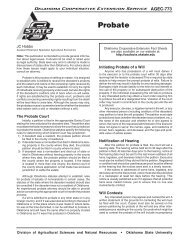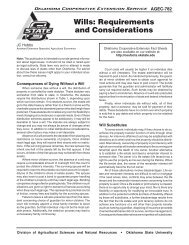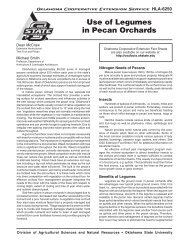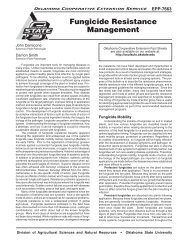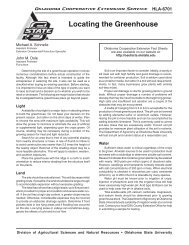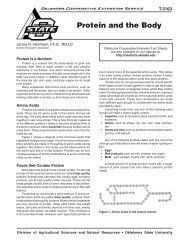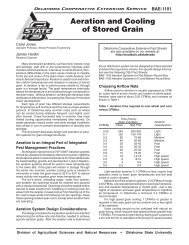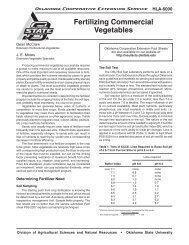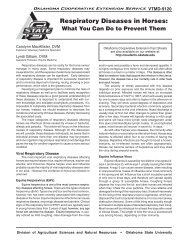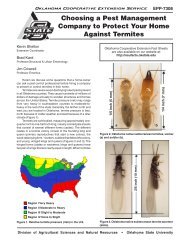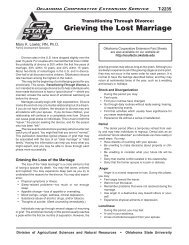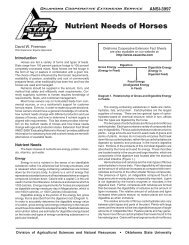Biology and Control of the Pecan Weevil in Oklahoma - OSU Fact ...
Biology and Control of the Pecan Weevil in Oklahoma - OSU Fact ...
Biology and Control of the Pecan Weevil in Oklahoma - OSU Fact ...
You also want an ePaper? Increase the reach of your titles
YUMPU automatically turns print PDFs into web optimized ePapers that Google loves.
• You cannot adequately account for weevil immigration<br />
<strong>in</strong>to <strong>the</strong> orchard from adjacent unprotected orchards or<br />
native trees.<br />
Figure 7. <strong>Weevil</strong> larvae feed<strong>in</strong>g <strong>in</strong> a pecan nut.<br />
lays <strong>in</strong> mat<strong>in</strong>g, egg maturation <strong>and</strong> oviposition have been<br />
observed <strong>in</strong> late matur<strong>in</strong>g <strong>and</strong>/or large-seeded cultivars.<br />
Research suggests that female weevils place a possible<br />
marker pheromone that prevents multiple weevils from lay<strong>in</strong>g<br />
eggs <strong>in</strong> a s<strong>in</strong>gle nut; however, if <strong>in</strong>festations reach <strong>in</strong>credibly<br />
high levels (90 percent or more), <strong>and</strong> limited oviposition sites<br />
are available, <strong>the</strong>n multiple oviposition events may occur. Of<br />
course, <strong>the</strong> consequence <strong>of</strong> pecan weevil oviposition <strong>in</strong> pecan<br />
is an unmarketable product <strong>and</strong> cont<strong>in</strong>ued proliferation <strong>of</strong> <strong>the</strong><br />
population throughout <strong>the</strong> orchard.<br />
With this <strong>in</strong> m<strong>in</strong>d, it is important to underst<strong>and</strong> how <strong>the</strong><br />
weevil develops <strong>and</strong> makes its way to <strong>the</strong> pecan tree to see<br />
<strong>the</strong> importance <strong>of</strong> monitor<strong>in</strong>g <strong>and</strong> trapp<strong>in</strong>g. Complete recommendations<br />
on trapp<strong>in</strong>g pecan weevils can be obta<strong>in</strong>ed <strong>in</strong><br />
<strong>OSU</strong> Extension <strong>Fact</strong> Sheet EPP-7190. Once a threshold is<br />
reached <strong>in</strong> an orchard or grove, treatment should be applied<br />
with an airblast sprayer calibrated to deliver a m<strong>in</strong>imum <strong>of</strong><br />
100 gallons per acre (Figure 8). Airblast sprayers come <strong>in</strong><br />
a number <strong>of</strong> sizes. Larger sprayers can reach <strong>the</strong> tops <strong>of</strong><br />
trees <strong>in</strong> excess <strong>of</strong> 80 feet <strong>and</strong> provide excellent coverage<br />
to <strong>the</strong> entire canopy. Regardless <strong>of</strong> <strong>in</strong>secticide selected,<br />
multiple applications will likely be needed throughout <strong>the</strong><br />
weevil season, especially if nuts are marketed for retail sales.<br />
To ensure penetration <strong>and</strong> through coverage, commercial<br />
growers should be encouraged to treat both sides <strong>of</strong> each<br />
tree. Traditionally, <strong>in</strong>secticide choices for many growers that<br />
allow livestock to graze <strong>in</strong> <strong>the</strong>ir orchards were limited to Sev<strong>in</strong><br />
<strong>in</strong>secticide, which is still an effective <strong>and</strong> safe choice for most<br />
applicators. Because <strong>of</strong> <strong>in</strong>creas<strong>in</strong>g costs associated with this<br />
product, <strong>and</strong> excellent efficacy <strong>of</strong> some newer generation<br />
pyrethroids, this chemistry has become more common. For<br />
a complete list<strong>in</strong>g <strong>of</strong> <strong>in</strong>secticide recommendations on pecan,<br />
<strong>in</strong>clud<strong>in</strong>g <strong>in</strong>formation on fungicides to protect trees from scab<br />
<strong>in</strong>fection, consult <strong>OSU</strong> Current Report CR-6209. This publication<br />
is revised each year <strong>and</strong> conta<strong>in</strong>s detailed, current<br />
<strong>in</strong>formation on pesticide recommendations for pecan.<br />
<strong>Control</strong>l<strong>in</strong>g <strong>Weevil</strong> Populations<br />
S<strong>in</strong>ce most <strong>of</strong> <strong>the</strong> life stages <strong>of</strong> <strong>the</strong> pecan weevil <strong>in</strong>habit<br />
protected environments, applications used to control this pest<br />
are generally targeted at <strong>the</strong> adult stage. Many attempts<br />
have been made by <strong>in</strong>dependent researchers <strong>and</strong> <strong>in</strong>dustry<br />
representatives to control weevil larvae <strong>in</strong> <strong>the</strong> soil us<strong>in</strong>g an<br />
<strong>in</strong>secticide. Unfortunately, several factors have lead to <strong>the</strong><br />
failure <strong>of</strong> this approach <strong>in</strong>clud<strong>in</strong>g:<br />
• <strong>Weevil</strong>s are diapaus<strong>in</strong>g dur<strong>in</strong>g this phase <strong>of</strong> development.<br />
Therefore, very little respiratory or o<strong>the</strong>r physiological<br />
activity is occurr<strong>in</strong>g <strong>in</strong> this stage.<br />
• Penetration <strong>of</strong> an <strong>in</strong>secticide <strong>in</strong>to <strong>the</strong> soil pr<strong>of</strong>ile to a depth<br />
<strong>of</strong> 6 to 9 <strong>in</strong>ches would be a big challenge for any chemical.<br />
• <strong>Weevil</strong> larvae <strong>and</strong> even pre-emergent adults are well<br />
protected with<strong>in</strong> an almost impenetrable ear<strong>the</strong>n cell.<br />
• Attempts to time applications when adult weevils first<br />
exit <strong>the</strong> soil cannot be well timed because <strong>of</strong> <strong>the</strong> <strong>of</strong>ten<br />
prolonged emergence pattern exhibited by this species.<br />
Figure 8. Airblast sprayer used for treat<strong>in</strong>g pecan orchards<br />
for pecan weevil <strong>and</strong> o<strong>the</strong>r pests.<br />
<strong>Oklahoma</strong> State University, <strong>in</strong> compliance with Title VI <strong>and</strong> VII <strong>of</strong> <strong>the</strong> Civil Rights Act <strong>of</strong> 1964, Executive Order 11246 as amended, Title IX <strong>of</strong> <strong>the</strong> Education Amendments <strong>of</strong> 1972, Americans<br />
with Disabilities Act <strong>of</strong> 1990, <strong>and</strong> o<strong>the</strong>r federal laws <strong>and</strong> regulations, does not discrim<strong>in</strong>ate on <strong>the</strong> basis <strong>of</strong> race, color, national orig<strong>in</strong>, gender, age, religion, disability, or status as a veteran <strong>in</strong><br />
any <strong>of</strong> its policies, practices, or procedures. This <strong>in</strong>cludes but is not limited to admissions, employment, f<strong>in</strong>ancial aid, <strong>and</strong> educational services.<br />
Issued <strong>in</strong> fur<strong>the</strong>rance <strong>of</strong> Cooperative Extension work, acts <strong>of</strong> May 8 <strong>and</strong> June 30, 1914, <strong>in</strong> cooperation with <strong>the</strong> U.S. Department <strong>of</strong> Agriculture, <strong>the</strong> Director <strong>of</strong> Cooperative Extension Service,<br />
<strong>Oklahoma</strong> State University, Stillwater, <strong>Oklahoma</strong>. This publication is pr<strong>in</strong>ted <strong>and</strong> issued by <strong>Oklahoma</strong> State University as authorized by <strong>the</strong> Vice President, Dean, <strong>and</strong> Director <strong>of</strong> <strong>the</strong> Division <strong>of</strong><br />
Agricultural Sciences <strong>and</strong> Natural Resources <strong>and</strong> has been prepared <strong>and</strong> distributed at a cost <strong>of</strong> 20 cents per copy. 0413 Revised. GH.<br />
EPP-7079-4


